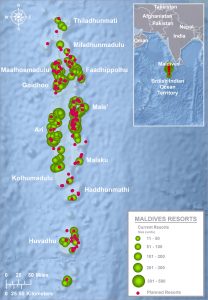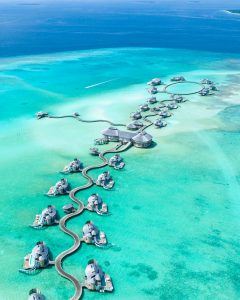68 South Asia: Economic Geography I –
Tourism in the Maldives
What are these dots? Is this a QR code? No. As you have seen and will see in various chapters, we like to feature outline maps of countries at the beginnings of chapters. So, yes, this is a sort of outline of the Maldive Islands. Well, that’s not very satisfying.

Public Domain.
Could we go with a satellite image? This one features some of the Maldives, especially Maalhosmadulu Atoll. An atoll is a ring-shaped coral reef that may include coral islands. The Maldives or Maldive Islands are a set of very small coral islands of very low elevation. Straddling the equator there are 26 atolls, but nearly 1200 islands. All of these islands total only 115 square miles, though they are dispersed over about 90,000 square miles of the Indian Ocean.

This tiny island country easily could be totally disregarded, if it were not for its tropical location. It is nearly invisible on any small scale maps. With natural elevation ranging from 0-17 feet above sea level, it is the world’s lowest-lying country.
Nevertheless, a tropical island has tourist value. Imagine spending vacation in one of these lodgings in the photo below. A few mere feet above the azure waters of the Indian Ocean. Soak in the sun’s rays daily, as the average daily temperatures range from 81.9°F to 84.6°F.
Probably, all island countries feature fishing as a noted element of their economies, so this is true for the Maldives as well. Okay, sure, but since tourism began with the opening of a resort in 1972, indeed tourism has been the key element of the economy. Many of the islands are not used for residential populations, but are solely utilized for tourism. Before the pandemic, annual numbers of tourists had reached 1.5 million.
Although India is only a short distance from these islands, Indian citizens only total enough to put India in fifth place in terms of providing tourists to the Maldives. Again counting before the pandemic, China ranked as the #1 source of tourists to the Maldives. Increases in the prosperity and size of China’s middle class, as well as some relaxation of travel restrictions there, have broadened the numbers of Chinese traveling throughout the world.

Certainly, the allure of the tropical island is the main reason that travelers venture to the Maldives. The beach, the weather, the ocean! Yet, some tourists may find the island’s history of interest as well. From the 3rd century BC to the 12th century BCE, the islands’ people mainly practiced Buddhism. This era preceded African and Arabic traders’ travels to the islands. In the mid-12th century, the king of the Maldives converted the population to Islam.
In 1558, a European period began with Portuguese authority. Subsequent control switched to the Dutch in the 17th century and then to the British in 1796. Via changes starting in 1953, the Maldives secured its independence in 1965.

Even so, the Maldives could end up as a footnote in world history, if climate change is sufficiently significant. If global warming continues to cause melting of polar regions, the world’s oceans may rise. Some projections assert that by 2050, the Maldives will be unihabitable, as sea rise will submerge many of the islands, while wave action will make the slightly higher islands subject to frequent flooding. However, the people and the government of the Maldives are taking action rather than simply waiting to see what may happen. Consulting with the Netherlands (the gold standard of holding off the sea), the Maldives is looking to develop solutions – perhaps even floating cities.
Warming temperatures also affect the coral that are the bases for these islands. Heating of ocean waters can kill coral. Again, the government of the Maldives seeks to be proactive in providing underwater structures for coral development and regeneration.
Did you know?
The capital city is named Malé, not Male. The toponym (place name) does not refer to gender nor to the sex ratio of the population nor to the English language word male. The country name actually is means “the islands of Malé.” The city name Malé is pronounced Maa-leh.
The country name Maldives is pronounced Mal-deeves.
Cited and additional bibliography:
Crow, Genevieve. Tourism in the Maldive Islands. College of DuPage GIS Class, July 2022.
Ishan @seefromthesky on Unsplash. “Oneva Jani, Noonu Atoll, Maldives.” https://unsplash.com/photos/DtWyp_4YEes. December 26, 2017.
Marchant, Natalie. World Economic Forum. “Threatened by Rising Sea Levels, the Maldives Is Building a Floating City.” May 19, 2021. https://www.weforum.org/agenda/2021/05/maldives-floating-city-climate-change/.
NordNordWest. “Malé.” Own work, using United States National Imagery and Mapping Agency dataWorld Data Base II data. April 2009. Attribution-ShareAlike 3.0 Unported (CC BY-SA 3.0), https://commons.wikimedia.org/w/index.php?curid=5094756.


